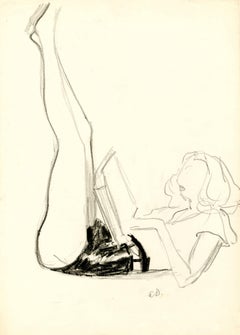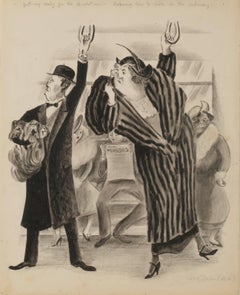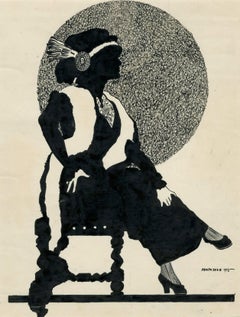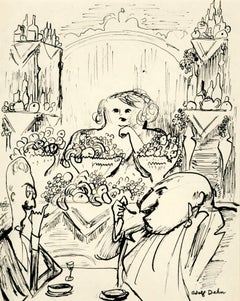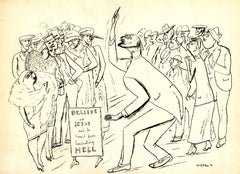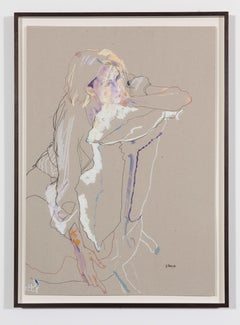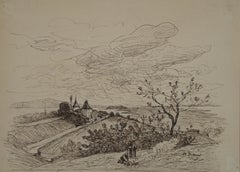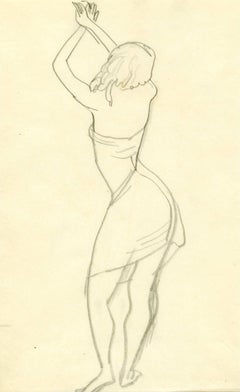Adolf Arthur Dehn Figurative Drawings and Watercolors
American, 1895-1968
Adolf Dehn, printmaker, watercolorist, and illustrator, was born in Waterville, Minnesota, in 1895. In 1914 he began studying at the Minneapolis School of Art, and in 1917, the year his first published drawing appeared in the progressive magazine, The Masses, he received a scholarship to study at the Art Students League in New York. There he worked with Kenneth Hayes Miller and was introduced to lithography by Boardman Robinson.
While in New York, Dehn threw himself into liberal politics. Declaring himself a conscientious objector in 1918, he was forced to spend four months in a Spartanburg, South Carolina, boot camp for refusing to serve in the armed forces and eight months as a volunteer instructor teaching painting and drawing at a hospital for war victims in Asheville, North Carolina.
Dehn spent the years 1920 to 1929 in art-related travel in Europe, primarily in Vienna and in Paris, where he made lithographs at the Atelier Desjobert. Throughout this time, Dehn exhibited his work at the Weyhe Gallery in New York and contributed drawings both to magazines abroad and to the radical journal The Masses.
Upon his return to New York in 1929, he became a leading figure in printmaking circles, exhibiting his prints to considerable critical acclaim. In 1937, Dehn had worked exclusively in black and white until 1937—halfway through his career—when he began to work in watercolor. During his summer visits to Minnesota, he created a large body of regional watercolors depicting the lakes and farms of his home state. Lithography and watercolor remained his two primary media, and his subjects ranged from social satire to naturalistic landscapes.
He authored the treatise, Water Color Painting, in 1945 and two other instructional books on lithography and watercolor in 1950 and 1955. From 1938 to 1939 he taught at Stephens College in Columbia, Missouri, and during the summers of 1940-1942 he taught at the Colorado Springs Fine Arts Center.
In 1939 and 1951 Dehn received Guggenheim Fellowships, and 1961 he was elected Full Academician to the National Academy of Design.
Dehn exhibited throughout his career, and his works are in the permanent collections of the Metropolitan Museum of Art, the Museum of Modern Art, the Art Institute of Chicago, the Museum of Fine Arts in Boston, and the British Museum, among others.
Adolf Dehn died in New York in 1968.(Biography provided by Robert Azensky Fine Art)
to
5
4
1
5
Overall Height
to
Overall Width
to
4
3
2
2
1
1
1
1
1
1
1
5
1
2
2
22
669
318
198
133
3
2
2
1
Artist: Adolf Arthur Dehn
Eileen Lake
By Adolf Arthur Dehn
Located in Fairlawn, OH
Eileen Lake
Crayon on paper, early1930's
Initialed in pencil lower right (see photo)
Titled and annotated verso "Eileen Lake, early 1930s girlfriend"
Note: Eileen Hall Lake was an American poet and Adolf Dehn's girlfriend in the early 1930s.
Provenance:
Estate of the artist
By descent
Adolf Dehn, American Watercolorist and Printmaker, 1895-1968
Adolf Dehn was an artist who achieved extraordinary artistic heights, but in a very particular artistic sphere—not so much in oil painting as in watercolor and lithography. Long recognized as a master by serious print collectors, he is gradually gaining recognition as a notable and influential figure in the overall history of American art.
In the 19th century, with the invention of the rotary press, which made possible enormous print runs, and the development of the popular, mass-market magazines, newspaper and magazine illustration developed into an artistic realm of its own, often surprisingly divorced from the world of museums and art exhibitions, and today remains surprisingly overlooked by most art historians. Dehn in many regards was an outgrowth of this world, although in an unusual way, since as a young man he produced most of his illustrative work not for popular magazines, such as The Saturday Evening Post, but rather for radical journals, such as The Masses or The Liberator, or artistic “little magazines” such as The Dial. This background established the foundation of his outlook, and led later to his unique and distinctive contribution to American graphic art.
If there’s a distinctive quality to his work, it was his skill in introducing unusual tonal and textural effects into his work, particularly in printmaking but also in watercolor. Jackson Pollock seems to have been one of many notable artists who were influenced by his techniques.
Early Years, 1895-1922
For an artist largely remembered for scenes of Vienna and Paris, Adolf Dehn’s background was a surprising one. Born in Waterville, Minnesota, on November 22, 1895, Dehn was the descendent of farmers who had emigrated from Germany and homesteaded in the region, initially in a one-room log cabin with a dirt floor. Adolf’s father, Arthur Clark Dehn, was a hunter and trapper who took pride that he had no boss but himself, and who had little use for art. Indeed, during Adolf’s boyhood the walls of his bedroom and the space under his bed were filled with the pelts of mink, muskrats and skunks that his father had killed, skinned and stretched on drying boards. It was Adolf’s mother, Emilie Haas Dehn, a faithful member of the German Lutheran Evangelical Church, who encouraged his interest in art, which became apparent early in childhood. Both parents were ardent socialists, and supporters of Eugene Debs. In many ways Dehn’s later artistic achievement was clearly a reaction against the grinding rural poverty of his childhood.
After graduating from high school in 1914 at the age of 19—an age not unusual in farming communities at the time, where school attendance was often irregular—Dehn attended the Minneapolis School of Art from 1914 to 1917, whose character followed strongly reflected that of its director, Munich-trained Robert Kohler, an artistic conservative but a social radical. There Dehn joined a group of students who went on to nationally significant careers, including Wanda Gag (later author of best-selling children’s books); John Flanagan (a sculptor notable for his use of direct carving) Harry Gottlieb (a notable social realist and member of the Woodstock Art Colony), Elizabeth Olds (a printmaker and administrator for the WPA), Arnold Blanch (landscape, still-life and figure painter, and member of the Woodstock group), Lucille Lunquist, later Lucille Blanch (also a gifted painter and founder of the Woodstock art colony), and Johan Egilrud (who stayed in Minneapolis and became a journalist and poet).
Adolf became particularly close to Wanda Gag (1893-1946), with whom he established an intense but platonic relationship. Two years older than he, Gag was the daughter of a Bohemian artist and decorator, Anton Gag, who had died in 1908. After her husband died, Wanda’s mother, Lizzi Gag, became a helpless invalid, so Wanda was entrusted with the task of raising and financially supporting her six younger siblings. This endowed her with toughness and an independent streak, but nonetheless, when she met Dehn, Wanda was Victorian and conventional in her artistic taste and social values. Dehn was more socially radical, and introduced her to radical ideas about politics and free love, as well as to socialist publications such as The Masses and The Appeal to Reason.
Never very interested in oil painting, in Minneapolis Dehn focused on caricature and illustration--often of a humorous or politically radical character. In 1917 both Dehn and Wanda won scholarships to attend the Art Students League, and consequently, in the fall of that year both moved to New York. Dehn’s art education, however, ended in the summer of 1918, shortly after the United States entered World War I, when he was drafted to serve in the U. S. Army. Unwilling to fight, he applied for status as a conscientious objector, but was first imprisoned, then segregated in semi-imprisonment with other Pacifists, until the war ended. The abuse he suffered at this time may well explain his later withdrawal from taking political stands or making art of an overtly political nature. After his release from the army, Dehn returned to New York where he fell under the spell of the radical cartoonist Boardman Robinson and produced his first lithographs. He also finally consummated his sexual relationship with Wanda Gag.
The Years in Europe: 1922-1929
In September of 1921, however, he abruptly departed for Europe, arriving in Paris and then moving on to Vienna. There in the winter of 1922 he fell in love with a Russian dancer, Mura Zipperovitch, ending his seven-year relationship with Wanda Gag. He and Mura were married in 1926. It was also in Vienna that he produced his first notable artistic work.
Influenced by European artists such as Jules Pascin and Georg Grosz, Dehn began producing drawings of people in cafes, streets, and parks, which while mostly executed in his studio, were based on spontaneous life studies and have an expressive, sometimes almost childishly wandering quality of line. The mixture of sophistication and naiveté in these drawings was new to American audiences, as was the raciness of their subject matter, which often featured pleasure-seekers, prostitutes or scenes of sexual dalliance, presented with a strong element of caricature. Some of these drawings contain an element of social criticism, reminiscent of that found in the work of George Grosz, although Dehn’s work tended to focus on humorous commentary rather than savagely attacking his subjects or making a partisan political statement. Many Americans, including some who had originally been supporters of Dehn such as Boardman Robinson, were shocked by these European drawings, although George Grocz (who became a friend of the artist in this period) admired them, and recognized that Dehn could also bring a new vision to America subject matter. As he told Dehn: “You will do things in America which haven’t been done, which need to be done, which only you can do—as far at least as I know America.”
A key factor in Dehn’s artistic evolution at this time was his association with Scofield Thayer...
Category
1930s American Realist Adolf Arthur Dehn Figurative Drawings and Watercolors
Materials
Oil Crayon
Getting Ready for the Revolution - Learning How to Ride in the Subway
By Adolf Arthur Dehn
Located in Fairlawn, OH
Signed: Adolf Dehn (VED) lower right corner (signed by Virginia Dehn, the artist’s widow); Tilted along the upper edge of the recto in pencil by the artist Verso inscriptions: “VF 3168.D” in a circle, also annotated in red pencil “32” in a circle and “699
Provenance:
Mary Ryan...
Category
1930s Adolf Arthur Dehn Figurative Drawings and Watercolors
Materials
Oil Crayon
untitled (Lesson 3)
By Adolf Arthur Dehn
Located in Fairlawn, OH
Signed and dated by the artist in ink, lower right
Annotated in ink lower left: 3.
Plate 15. - Lesson 3
A very early student work.
From the Artist's estate
Category
1910s Adolf Arthur Dehn Figurative Drawings and Watercolors
Materials
Ink
Cornucopia
By Adolf Arthur Dehn
Located in Fairlawn, OH
Signed by the artist in ink lower right
Preliminary sketch in reverse for the 1928 lithograph "Cornucopia," part of Dehn's Paris Lithographs portfolio
An unsigned sketch of tw...
Category
1920s Adolf Arthur Dehn Figurative Drawings and Watercolors
Materials
Ink
Believe in Jesus and be saved from everlasting Hell
By Adolf Arthur Dehn
Located in Fairlawn, OH
Signed and dated lower right
Provenance:
Estate of the artist
Ink on paper
Category
1920s Adolf Arthur Dehn Figurative Drawings and Watercolors
Materials
India Ink
Related Items
Freya (Seated Backwards), Mixed media on grey board
By Howard Tangye
Located in London, GB
Howard Tangye (b.1948, Australia) has been an influential force in fashion for decades. Lecturing at London’s Central Saint Martins for 35 years, including 16 years as head of BA Wom...
Category
2010s Contemporary Adolf Arthur Dehn Figurative Drawings and Watercolors
Materials
Other Medium, Archival Paper, Handmade Paper, Pen, Felt Pen, Permanent M...
Alfred Dumont (1828-1894) - Cerlier in Switzerland - 19thC Ink Landscape Drawing
By Alfred Paul Emil Etienne Dumont
Located in Meinisberg, CH
Alfred Paul Emil Etienne Dumont
(Swiss, * 13. Juni 1828 in Baulmes; † 7th August 1894 in Geneva)
Vue de Cerlier au lac de Bienne avec Île Saint-Pierre
(Figures at an open fire, wit...
Category
1860s Naturalistic Adolf Arthur Dehn Figurative Drawings and Watercolors
Materials
Paper, India Ink
Free Shipping
H 8.86 in W 12.01 in D 0.01 in
Tom Cawson (Sitting - Hand on Head), Mixed media on grey cardboard
By Howard Tangye
Located in London, GB
Howard Tangye (b.1948, Australia) has been an influential force in fashion for decades. Lecturing at London’s Central Saint Martins for 35 years, including 16 years as head of BA Wom...
Category
21st Century and Contemporary Contemporary Adolf Arthur Dehn Figurative Drawings and Watercolors
Materials
Other Medium, Paint, Graphite, Color Pencil, Carbon Pencil, Pencil, Pen,...
French Mid Century Picasso Influenced Zoomorphic Female Nude
Located in Cotignac, FR
French Mid Century Picasso Influenced stylised zoomorphic female nude drawing, oil crayon on paper, Paris School, signed and dated 1963. The work is presented in a chrome period fram...
Category
1960s Modern Adolf Arthur Dehn Figurative Drawings and Watercolors
Materials
Oil Crayon, Paper, Pastel
Zoomorphic composition, 1979, India ink on paper
Located in PARIS, FR
Alena NADVORNIKOVA (née en 1942)
Zoomorphic composition, 1979
India ink on paper
Signed and dated "1979" lower left
50 x 32 cm
Frame : 60 x 40 cm
A Czech artist born in 1942 in Lipn...
Category
1970s Adolf Arthur Dehn Figurative Drawings and Watercolors
Materials
India Ink
Village - Original China Ink on Paper - 20th Century
Located in Roma, IT
Village is an original drawing in China ink on paper realized by an Anonymous artist of the XX century.
The State of preservation is very good wit...
Category
20th Century Contemporary Adolf Arthur Dehn Figurative Drawings and Watercolors
Materials
India Ink, Paper
Rajput School, 17th century Krishna with his beloved, Radha; from Mahabharata
Located in Middletown, NY
Vishnu in the form of Krishna being serenaded with his beloved Radha. An illuminated page from the epic of Mahabharata
circa 1690. Gouache and ink with gold heightening on cream lai...
Category
18th Century Rajput Adolf Arthur Dehn Figurative Drawings and Watercolors
Materials
Gold
Dva svety (Two Worlds), 1979, India ink on paper
Located in PARIS, FR
Alena NADVORNIKOVA (née en 1942)
Dva svety (Two Worlds), 1979
India ink on paper
Titled "Dva svety", signed and dated "79" lower left
50 x 32 cm
Frame : 60 x 40 cm
A Czech artist bo...
Category
1970s Adolf Arthur Dehn Figurative Drawings and Watercolors
Materials
India Ink
Mughal School, 17th century Tiger Hunt near the Jahangir Maha, Agra
Located in Middletown, NY
An illuminated page from a book likely in reference to palace life during Emperor Jahangir's reign over the Mughal Empire.
c 1690. Gouache and ink with heightening in gold on light ...
Category
17th Century Rajput Adolf Arthur Dehn Figurative Drawings and Watercolors
Materials
Gold
"Dragon, " Original Pastel Drawing
By Quang Ho
Located in Denver, CO
"Dragon," by Quang Ho, is a secondary market work with one previous owner. It is signed and dated (1988) on the lower left. The painting comes with it's original frame (measures 50 x...
Category
20th Century American Realist Adolf Arthur Dehn Figurative Drawings and Watercolors
Materials
Paper, Pastel
Modernist Abstract Nude Figurative Painting in India Ink on Paper
By Louis Nadalini
Located in Soquel, CA
Modern abstracted nude figurative study in bold black ink by Louis Nadalini (American, 1927-1995). Signed in the top left corner under the mat, "L Nadalini"...
Category
Late 20th Century Abstract Expressionist Adolf Arthur Dehn Figurative Drawings and Watercolors
Materials
Paper, India Ink
H 28 in W 22 in D 0.25 in
Expressionist Ink, Pastel, Crayon Drawing Jewish American Modernist Ben Zion WPA
By Ben-Zion Weinman
Located in Surfside, FL
Expressionist ink and pastel crayon drawing of beans (carobs, flowers?) in pods
Hand signed.
Born in 1897, Ben-Zion Weinman celebrated his European Jewish heritage in his visual works as a sculptor, painter, and printmaker. Influenced by Spinoza, Knut Hamsun, and Wladyslaw Reymont, as well as Hebrew literature, Ben-Zion wrote poetry and essays that, like his visual work, attempt to reveal the deep “connection between man and the divine, and between man and earth.” An emigrant from the Ukraine, he came to the US in 1920. He wrote fairy tales and poems in Hebrew under the name Benzion Weinman, but when he began painting he dropped his last name and hyphenated his first, saying an artist needed only one name.
Ben-Zion was a founding member of “The Ten: An Independent Group” The Ten” a 1930’s avant-garde group, Painted on anything handy. Ben-Zion often used cabinet doors (panels) in his work. Other members of group included Ilya Bolotowsky, Lee Gatch, Adolph Gottlieb, Louis Harris, Yankel Kufeld, Marcus Rothkowitz (later known as Mark Rothko), Louis Schanker, and Joseph Solman. The Art of “The Ten” was generally described as expressionist, as this style offered the best link between modernism and social art. Their exhibition at the Mercury Gallery in New York held at the same time as the Whitney Annual Exhibition of Contemporary American Painting, included a manifesto concentrating on aesthetic questions and criticisms of the conservative definition of modern art imposed by the Whitney. Ben-Zion’s work was quickly noticed. The New York Sun said he painted “furiously” and called him “the farthest along of the lot.” And the triptych, “The Glory of War,” was described by Art News as “resounding.”
By 1939, The Ten disbanded because most of the members found individual galleries to represent their work. Ben-Zion had his first one-man show at the Artist’s Gallery in Greenwich Village and J.B. Neumann, the highly esteemed European art dealer who introduced Paul Klee, (among others) to America, purchased several of Ben-Zion’s drawings. Curt Valentin, another well-known dealer, exhibited groups of his drawings and undertook the printing of four portfolios of etchings, each composed of Ben-Zion’s biblical themes. He worked as a WPA artist.
Ben-Zion’s work is represented in many museums throughout the country including the Metropolitan, the Whitney, and the Museum of Modern Art in New York, the Art Institute of Chicago, the Philadelphia Museum of Art and the Phillips Collection, Washington. The Jewish Museum in New York opened in 1948 with a Ben-Zion exhibition.
Ben-Zion consistently threaded certain subject matter—nature, still life, the human figure, the Hebrew Bible, and the Jewish people—into his work throughout his life. "In all his work a profound human feeling remains. Sea and sky, even sheaves of wheat acquire a monolithic beauty and simplicity which delineates the transient as a reflection of the eternal. This sensitive inter- mingling of the physical and metaphysical is one of the most enduring features of Ben-Zion's works." (Excerpt from Stephen Kayser, “Biblical Paintings,” The Jewish Museum Catalogue, 1952). Mystical Imprints: Marc Chagall, Ben-Zion, and Ben Shahn presents the print work of three prominent 20th century Jewish artists born in the Russian Empire. Among these seventy pieces are etchings and lithographs from Chagall’s Bible series...
Category
Mid-20th Century Expressionist Adolf Arthur Dehn Figurative Drawings and Watercolors
Materials
Paper, Oil Crayon, Pastel, Ink
Previously Available Items
Brancusi
By Adolf Arthur Dehn
Located in Denver, CO
Portrait of sculptor, Constantin Brâncuși (1876-1957).
Graphite on paper. Housed in a custom frame with archival materials. Outer dimensions are 17.5 x 14.5 x 0.75 inches; image m...
Category
Mid-20th Century American Modern Adolf Arthur Dehn Figurative Drawings and Watercolors
Materials
Graphite
Untitled (Woman with Upraised Arms)
By Adolf Arthur Dehn
Located in Fairlawn, OH
Pencil on paper
Unsigned
Provenance:
Estate of the artist
From a sketchbook
Category
1920s Adolf Arthur Dehn Figurative Drawings and Watercolors
Materials
Graphite
Adolf Arthur Dehn figurative drawings and watercolors for sale on 1stDibs.
Find a wide variety of authentic Adolf Arthur Dehn figurative drawings and watercolors available for sale on 1stDibs. You can also browse by medium to find art by Adolf Arthur Dehn in ink, crayon, oil crayon and more. Not every interior allows for large Adolf Arthur Dehn figurative drawings and watercolors, so small editions measuring 9 inches across are available. Customers who are interested in this artist might also find the work of Thelma Terrell, Monte Crews, and Michael Loew. Adolf Arthur Dehn figurative drawings and watercolors prices can differ depending upon medium, time period and other attributes. On 1stDibs, the price for these items starts at $1,200 and tops out at $3,500, while the average work can sell for $2,500.
